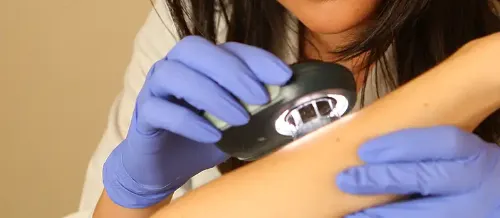Pityriasis versicolor
"The prognosis is good and the treatment is resolving, although relatively often the patient may have another episode, especially if the predisposing factors persist".
DR. NURIA RODRÍGUEZ
SPECIALIST. DERMATOLOGY DEPARTMENT

Pityriasis versicolor is a phytoparasitic dermatosis, these are skin conditions resulting from parasitation of fungi; these are plants that do not carry out the phenomenon of photosynthesis.
They are part of the group of the most frequent diseases that affect man, and it can even be said that practically everyone will suffer from them at some point in their lives.
There are three types of human mycosis: superficial, intermediate like candidiasis and deep.
The color changes can remain several months after the fungus has been eliminated.
The prognosis is good and the treatment is resolute, although relatively often the patient may have another episode, especially if the predisposing factors, both exogenous and endogenous, described above persist.
To prevent recurrence, special gels should be used once or twice at the beginning of the month.

What are the symptoms of pityriasis?
The patient usually consults because they have rounded spots, brown in winter and whitish in summer, located on the upper back, shoulders and neck. Sometimes they can show up as pustular follicular lesions in those same locations.
The name of this mycosis "versicolor", refers to the change in tone that the lesions have in the summer with respect to winter.
In winter, the affected skin areas have a pink or brown coloration and in summer they acquire a whitish color, since the fungus located on the skin prevents solar radiation from pigmenting that area and also produces a substance that slows down the pigmentation.
Most common symptoms:
- Rounded spots.
- Change in color of the spots in the different months.
- Scaling with friction.
Do you have any of these symptoms?
You may have pityriasis versicolor
What are the causes of ptyriasis?
The etiological agent is Pityrosporum Ovale. It is a saprophytic fungus, that is, it lives on our skin without producing disease.
Since everyone possesses this fungus, the disease is not contagious. It is not transmitted either directly or indirectly by the scales that appear on the lesions.
Who can suffer from it?
It can affect people of any age group and is most common in young adults.
There are a number of predisposing factors such as high temperature and relative humidity, application of oils, excessive sweating, seborrheic skin, immunosuppressive treatments or debilitating diseases.
How is pityriasis diagnosed?

To make the diagnosis, in addition to basing ourselves on the clinic, we help ourselves by scraping the lesions with a teaspoon, observing how agglutinated scales are detached in the form of a lamina (sign of the fingernail).
With Wood's light, the lesions emit a yellowish fluorescence.
How is pityriasis versicolor treated?
In most cases a topical treatment is sufficient. Washing with selenium sulfide is indicated for the first three days, maintaining the foam for fifteen minutes. This is complemented by the application of topical antifungals such as ketoconazole, miconazole or terbinafine.
Another option, perhaps more aggressive, is the oral administration of antifungals such as ketoconazole, fluconazole or itraconazole that can have side effects at the liver level and are more expensive.
Where do we treat it?
IN NAVARRA AND MADRID
The Department of Dermatology
of the Clínica Universidad de Navarra
The Department of Dermatology of the Clinica Universidad de Navarra has extensive experience in the diagnosis and treatment of dermatological diseases.
We have extensive experience in highly precise surgical treatments, such as Mohs surgery. This procedure requires highly specialized personnel.
We have the latest technology for the dermo-aesthetic treatment of skin lesions, with the aim of achieving the best results for our patients.
Diseases we treat

Why at the Clinica?
- Experts in Mohs Surgery for the treatment of skin cancer.
- We have the best technology for dermo-aesthetic treatments.
- Safety and quality assurance of the best private hospital in Spain.








